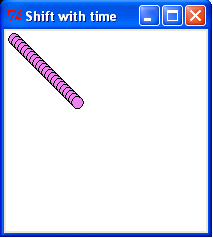Here we introduce the time control function canvas.after(milliseconds) and the canvas.update() function that refreshes the image on the canvas. These are the cornerstones of animation in Python.
Control of when code gets executed is made possible by the time module that comes with the standard Python library.
Execute the program as previously. What you will see is a diagonal row of disks being laid in a line with a short delay of one fifth of a second (200 milliseconds) between updates. The result is shown in the following screenshot showing the ball shifting in regular intervals.

# timed_moveball_1.py
#>>>>>>>>>>>>>>>>>>>>>>>>>>>>>>>>>>>>>>>>>>>>
from Tkinter import *
root = Tk()
root.title("Time delayed ball drawing")
cw = 300 # canvas width
ch = 130 # canvas height
chart_1 = Canvas(root, width=cw, height=ch, background="white")
chart_1.grid(row=0, column=0)
cycle_period = 200 # time between fresh positions of the ball
# (milliseconds).
# The parameters determining the dimensions of the ball and it's # position.
posn_x = 1 # x position of box containing the ball (bottom).
posn_y = 1 # y position of box containing the ball (left edge).
shift_x = 3 # amount of x-movement each cycle of the 'for' loop.
shift_y = 3 # amount of y-movement each cycle of the 'for' loop.
ball_width = 12 # size of ball - width (x-dimension).
ball_height = 12 # size of ball - height (y-dimension).
color = "purple" # color of the ball
for i in range(1,50): # end the program after 50 position shifts.
posn_x += shift_x
posn_y += shift_y
chart_1.create_oval(posn_x, posn_y, posn_x + ball_width,
posn_y + ball_height, fill=color)
chart_1.update() # This refreshes the drawing on the canvas.
chart_1.after(cycle_period) # This makes execution pause for 200 # milliseconds.
root.mainloop()
This recipe is the same as the previous one except for the canvas.after(...) and the canvas.update() methods. These are two functions that come from the Python library. The first gives you some control over code execution time by allowing you to specify delays in execution. The second forces the canvas to be completely redrawn with all the objects that should be there. There are more complicated ways of refreshing only portions of the screen, but they create difficulties so they will not be dealt with here.
The canvas.after(your-chosen-milliseconds) method simply causes a timed-pause to the execution of the code. In all the preceding code, the pause is executed as fast as the computer can do it, then when the pause, invoked by the canvas.after() method is encountered, execution simply gets suspended for the specified number of milliseconds. At the end of the pause, execution continues as if nothing ever happened.
The canvas.update() method forces everything on the canvas to be redrawn immediately rather than wait for some unspecified event to cause the canvas to be refreshed.
The next step in effective animation is to erase the previous image of the object being animated shortly before a fresh, shifted clone is drawn on the canvas. This happens in the next example.
It is also worth noting that Tkinter is robust. When you give position coordinates that are off the canvas, Python does not crash or freeze. It simply carries on drawing the object 'off-the-page'. The Tkinter canvas can be seen as just a tiny window into an almost unlimited universe of visual space. We only see objects when they move into the view of the camera which is the Tkinter canvas.
